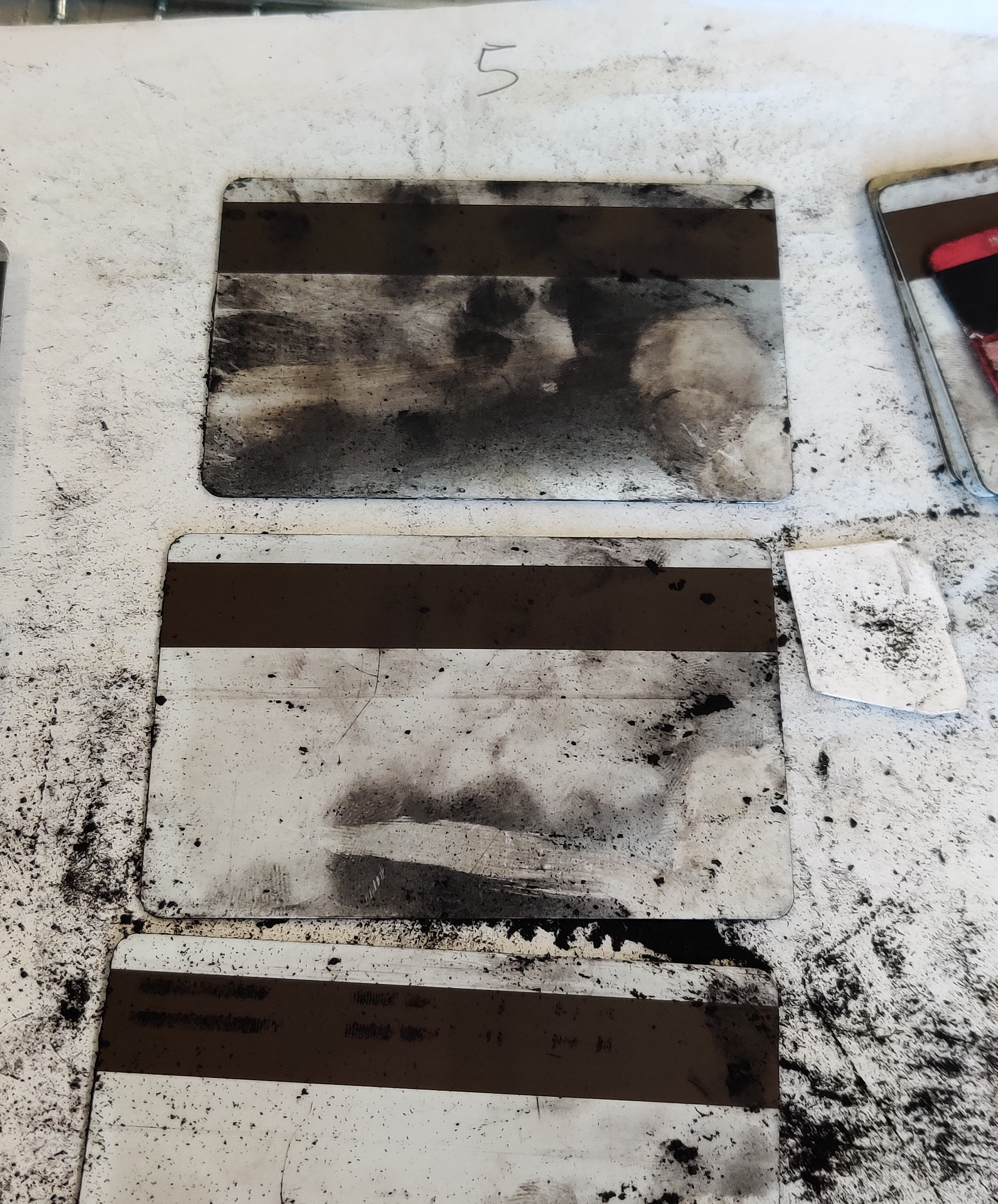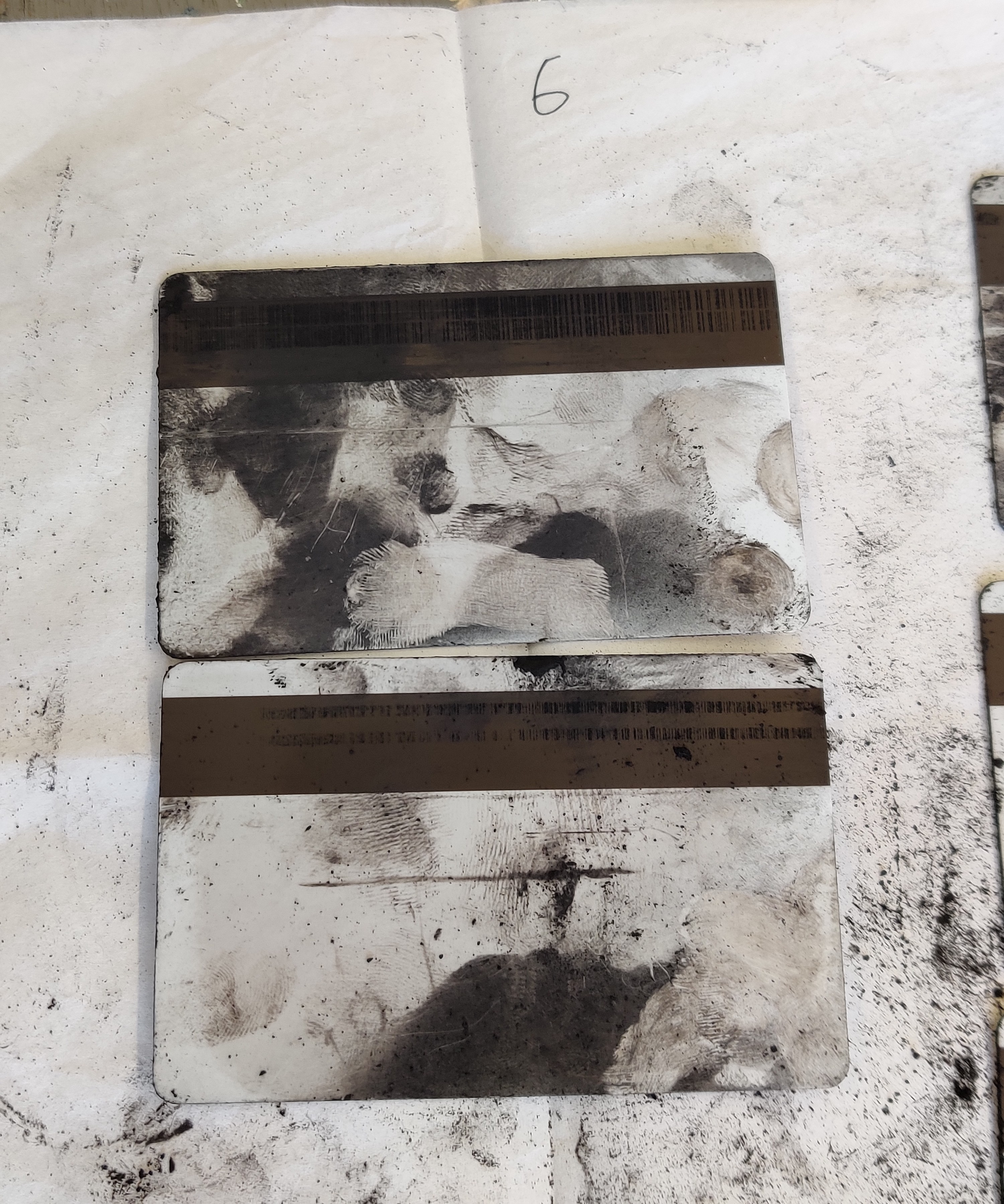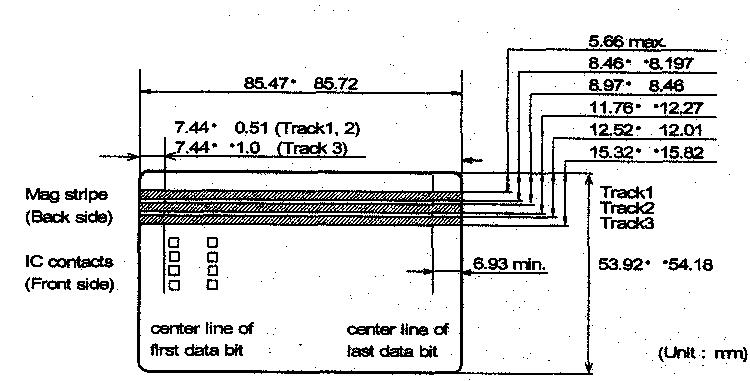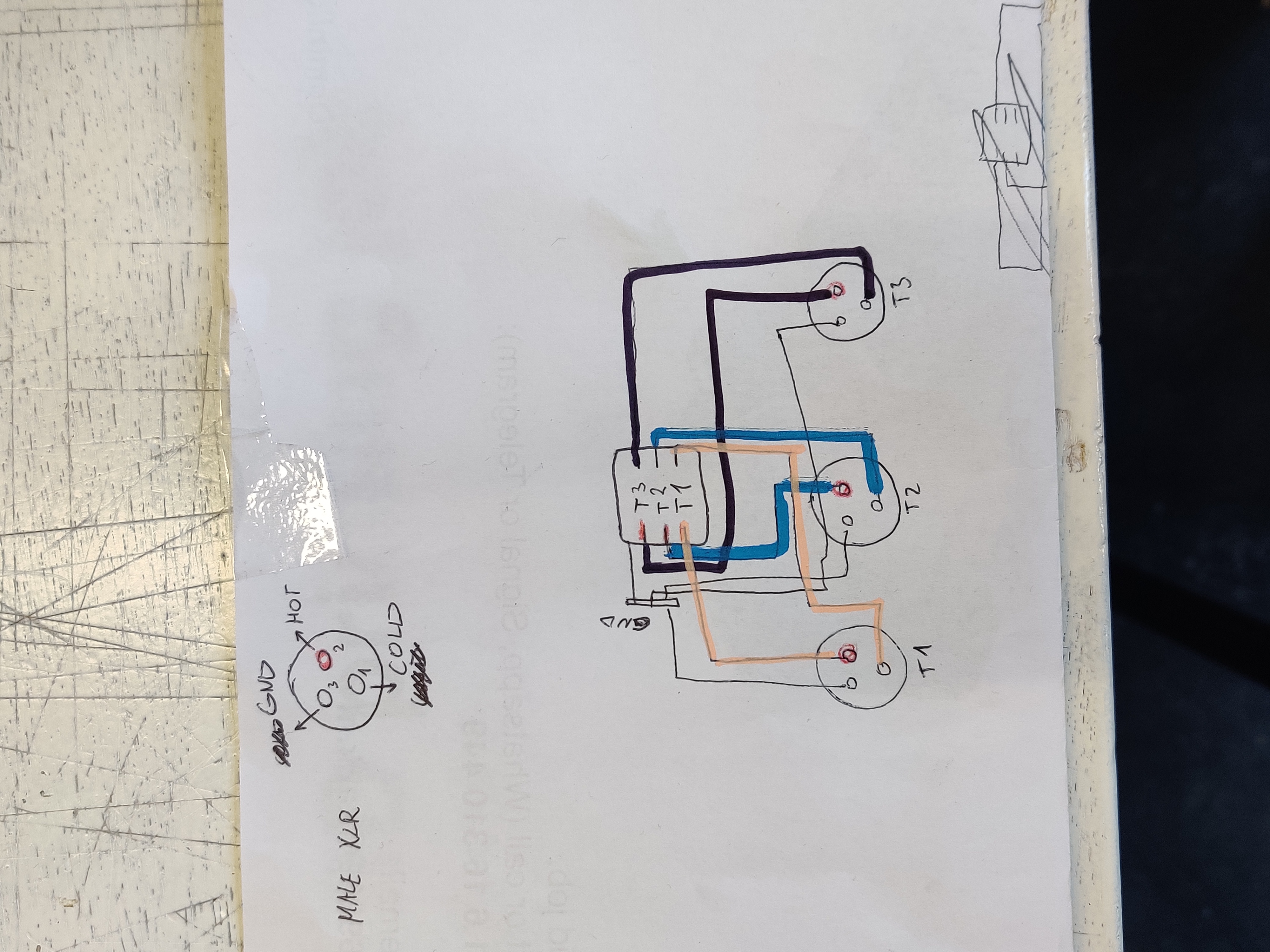How to record analog sound onto magnetic stripe of a credit card
ongoing research from 2025
Since November 2024 I got interested in bank card as an object that is both physical and digital, with its digital layers being part of an obscured network of dependencies and powers. Those cards serve as symbol status, a pass that lets some people into some places, that hold the record of our place in society.
There are three major technologies behind bank cards: NFC, chip, and magnetic stripe. After some tests with all three I decided to work with magnetic stripe, because of its analog nature that was easier to understand on substantial level.
Over a few months I build a simple magnetic card recorder that works with audio input instead of digital data ecryption. Since February I kept a logbook that you can read below.
Magnetic cards recorder reader short recipe:
Parts:
MSR605 card recorder/reader
2x male XLR plugs
some shielded mono cable
2x potentiometer
2x 44Ohm resistor
For recording:
Behringer Xenyx QX1204USB mixer
2 x XLR cable
1. Building the device
I took apart MSR and left only the rail with both magnetic heads. I took PCB and all the connectors out. It’s important to do this before soldering, otherwise PCB can get damaged. Measured resistance shows ~8Ohm on the recording head and ~34Ohm on the reading head. This is because the recording head must be able to produce strong signal to magnetize the stripe, and the reading head must be very sensitive to pick up whatever’s recorded.
I made two short connectors, with two paraller mono cables (more flexible and easier to solder than one stereo cable), and male XLR plug on the end.
Circuit for recording head goes as follows:
![]()
This circuit is added only to write head. The read head has only the XLR cable, added in the same way as in the circuit. I set potentiometers to 280Ohms, which I found works good. 44Ohm resistors protect the coils from excesive current. Battery, potentiometers and resistors create together a simple DC bias signal, that is mixed with audio signal from XLR connected to the head in paraller.
I used very short XLR’s, and connected them with longer f-m cables to mixer.
2. Recording
Before connecting the XLRs I connect the battery and set potentiometers. I send an audio signal from my laptop with mini Jack - 8’’ Jack adapter. I use only Right channel, since the device is one channel only. Some settings that worked best for me, especially compression for speech samples:
- up gain
- max compression
- up EQ high
- up EQ mid
I monitor the battery to keep it above ~8.5V, and plug it out after recording. If left overnight in the circuit it will run empty. I set the highest possible volume without clipping. On the main mix it hits the top of the orange 10. I output all to R channel, and send it to main R out, to the recording head via f-f adapter and XLR cable.
Recording audio is on loop in Audacity, I use headphones and my eyes to see when the audio start, and swipe the card in the right moment, starting just before the audio.
3. Playback
First I make sure I unplug the battery from bias circuit, otherwise it can wipe out my recording. Playback can be done with both heads, but the reading head is more sensitive, therefore the output is louder. Gain and lvl on the mixer have to be adjusted accordingly. I pan the sound to R and L speaker. I have to match the recording speed to hear the original sample pitch.
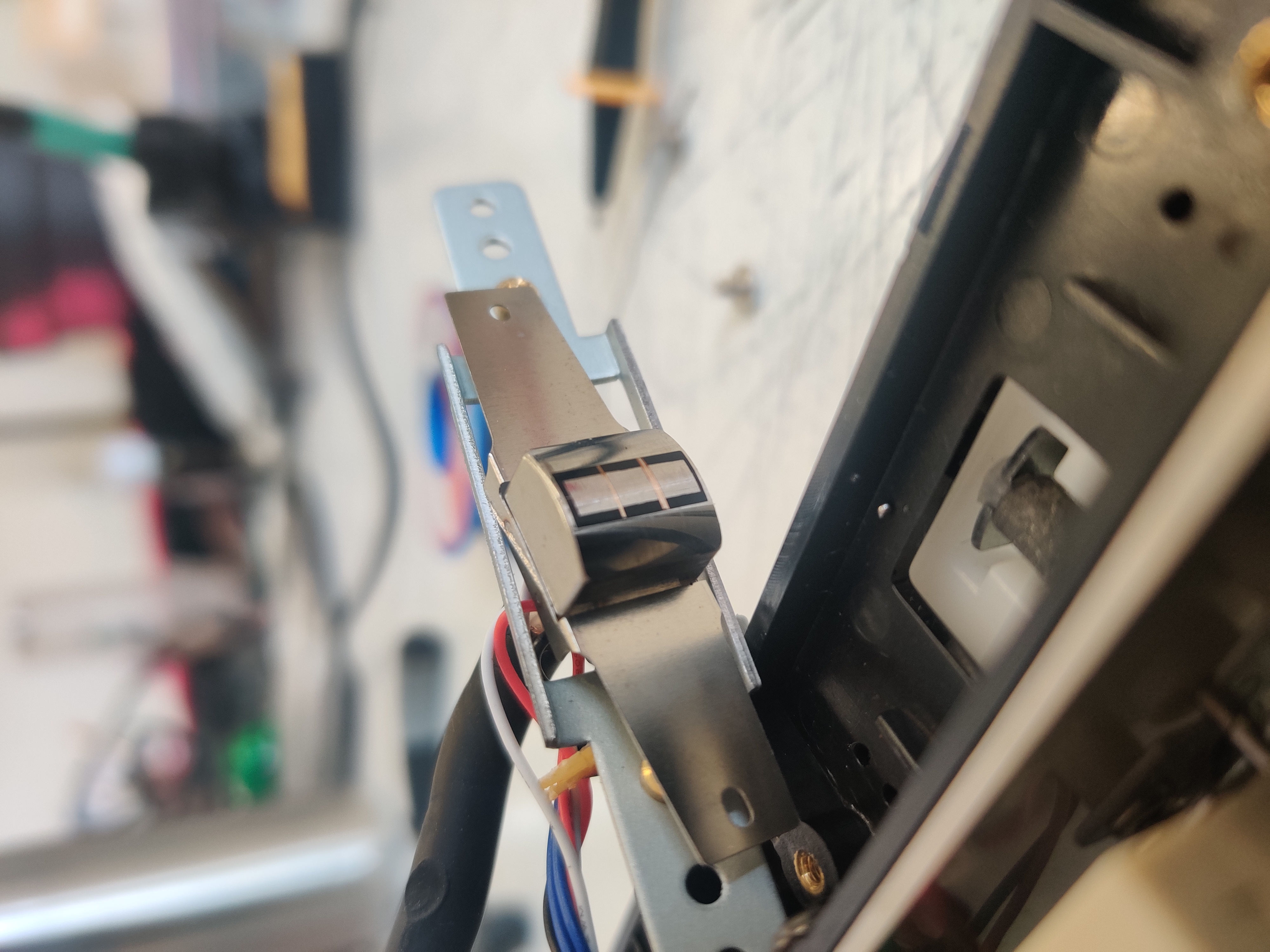
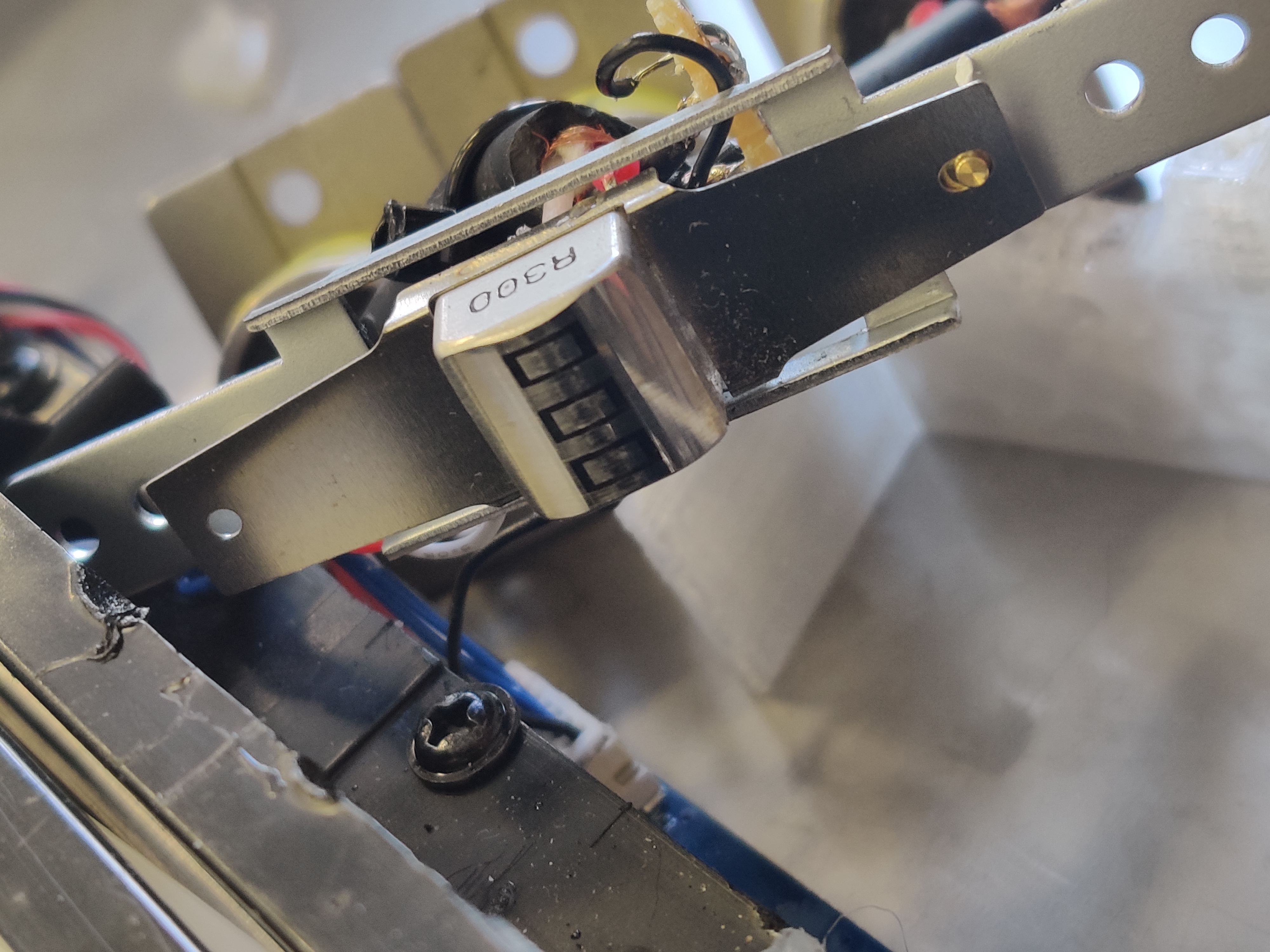
Left: Write head for magnetic cards has the coils way wider than tape head. It corresponds to track hight of 0.11inch (2.794 mm). Part name HW300.
Right: Read head has smaller coils than write head. Part name R300.
This build corresponds with the standard placement of the tracks on the cards:
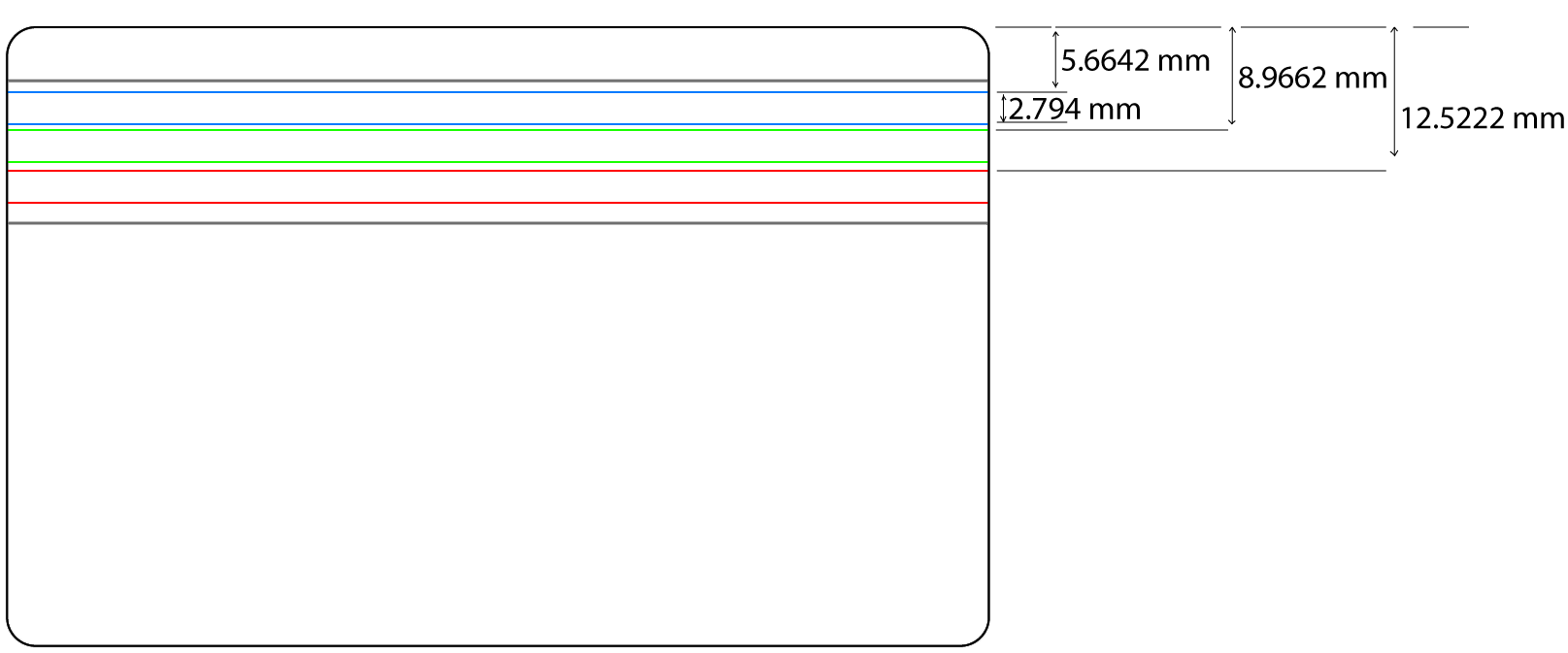
Those norms are described in ISO/IEC 7811 standard. It’s very hard to obtain this document without paying.
Magnetic cards sound recording logbook 02-06.2025.
23.02
Got speakers, amp, jacks and oscilloscope from Hacklab.
24.02
Soldered speaker cable, connected amp and tried two different tape heads (1) and (2).
(1) outputs very subtle sound. Measured voltage 0 (?).
(2) doesn’t output anything noticable. Measured out voltage 0.1 -0.3 mV on different cards.
https://github.com/seancolyer/pyMagStripe
https://blog.yossarian.net/assets/MSR206_User_Guide.pdf (MSR206 doc, 2003)
Found pyhton lib for magnetic stripes from 2012. Device used is MSR206. Compatible with iso/iec 7811 standard.
3.03
Talked to Lex and Gokay from EWP. MagStrip circuit needed pre amp, got Vellman diy one from Kiwi. Soldered it and added to the curcuit, cut the connections shorter. It’s louder but very noisy. Probably most of it is power supply (less noise when grounded), and also bare preamp connectins.
12.03
Made a switch circuit with relay. Connected Arduino to TD throught serial. Values incorrect and incoherent. Delay() not best for reading values on the same thread.
13.03
https://techeonics.com/ac-dimmer-module/
https://github.com/RobotDynOfficial/RBDDimmer
Changed relay to AC dimmer module. Tested example 1. code from RBDDimmer lib (SerialMonitorDim), works fine but slow (serial speed) :/ Made it work with values from credit cards send via Serial to Arduino (CardSwitch.toe).
17.03
Edited script to monitor for reader name, and add it to CardData DAT. Works well with two readers. Only the card data is send over serial, so that it affects the same light bulb. Also added Execute DAT with OnStart f to run script and clear CardData table.
Arduino sometimes disappear from serial port, reason unknow, but solved with new cable.
Code gave error from TD (requesting TD objects from separate thread?), but solved with laptop restart.
18.03
Switch off active par of Serial DAT added to OnStart. Then power in the whole building went of :/
19.03
Got another light to operate with two readers. Made both lights dim with the same value.
28.04
https://github.com/theriley106/magstripe-python - for MSR605/MSR605Xhttps://github.com/manwinder123/MSR605-Card-Reader-Writer-Eraser-with-GUI for MSR605https://www.colincrawley.com/audio-duration-calculator/
Magnetic stripe is disabled in the whole Netherlands in debit cards form Maestro and V pay. No way of charging visitors during the grad show. Bought one MSR505X reader from Amazon.
Data stored on magnetic strips:
tracks |
BPI = magnetic density, physical track property |
ISO encoding |
capacity |
vertical position from top edge |
|---|---|---|---|---|
Track 1 |
||||
IATA |
210 BPI |
7-bit encoding (6 bit + odd parity) |
~553 bits |
|
8-bit: |
||||
69 bytes |
||||
ISO: |
||||
79 alphanumeric char |
1,50 mm |
|||
Track 2 |
||||
ABA |
75 BPI |
5-bit encoding (4 bit + odd parity) |
~200 bits |
|
8-bit: |
||||
25 bytes |
||||
ISO: |
||||
40 num char |
2,54 mm |
|||
Track 3 |
||||
THRIFT |
210 BPI |
5-bit encoding (4 bit + odd parity) |
~535 bits |
|
8-bit: |
||||
67 bytes |
||||
ISO: |
||||
107 num char |
3,58 mm |
|||
MagStripe tracks hight: 2.794 mm.
Magstripe Sound Encoding
29.04
https://tagtixrfid.com/products/msr605x?srsltid=AfmBOorYNp73FLy2MqToiaiJYdxUlH3q9xvQfZC_3Up3rSaTK_CGuJqN&utm_source=chatgpt.com - MSR605X sw tutorials
Average human swiping speed: 0.3-0.5s. Stripe lenght: 3.37 inch. Sound bit rate for T1, T3: 1,77 kbps, for T2: 0,632 kbps. For combined T1-3: 4,2kbps. Total capacity T1 + T2 + T3 = 1288 bits, 161 bytes.
Sample duration: 0,4s., file type .wav.
Tracks interweaving ratio:
1 - 553 - ~43%
2 - 200 - ~15.5%
3 - 535 - ~ 41.5%
[bit 0] → Track 1
[bit 1] → Track 3
[bit 2] → Track 1
[bit 3] → Track 2
[bit 4] → Track 1
[bit 5] → Track 3
[bit 6] → Track 1
[bit 7] → Track 3
[bit 8] → Track 2
...
First tryout:
encoded Sample1, 0.4s, normalized. Exported from Audacity with 3.2kHz and 1.288 kHz rates. Converted with py script to 1288 bits. Saved as _list.txt and _string.txt. Then imported back to Audacity as Raw Data. Both _string files and _list files sound like random binary noise. No resemblance to sound wave at all. _list.txt slightly better.
Tried all kinds of combinations of time swiping and encoding. It seems like there is no way the sample would remain speech-like. 4 bit 0.25s most resembling speech. 8 bit 1s the nicest sounding low tone.
Conclusion:
It seems like there are 2 ways of making the credit cards samples:
tone-based magnetic strip samples
cassette tape forged strips
30.04
LoCo - low coercivity = requires strong mag field to read ~300 Oe
HiCo - high coercivity = requires lower mag field to read 2750–4000 Oe
Cassette tape is LoCo. Magnetic stripe in ISO/IEC 7811 can be both HiCo and LoCo. All cards I have are HiCo.
Tested cassette tape with my amp circuit. Sounds off but works. Volume a bit lower than from cards. Hard to pase correctly and hit the right track on head.
31.04
Tested Tymon’s mixer with tape head IN. Tape head is not line lvl, but closer to mic lvl. Maybe useful to use XLR instead of jack for the reader heads connections. Will dicuss this with EWP.
https://www.ocominc.com/products/MSR605X-usb-port-Magnetic-card-reader-and-wirtter.htmlInstalled driver (PL23XX) from Deftun website. MSRX og sw works!!!
Reading:
Error when: swipe in the wrong direction, remove card mid swipe, go back mid swipe, swpie very slow etc. No errors when swiping very fast.
measured max t ~ 0.28s (faster possible, no upper limit)
measured min t ~ 4.2s
Writing: Succesfull within ISO data format. Write to File: T1 and T2 write properly. T3 always reads 2, even when line empty. Tested formattings with + and ; at T3 new line start. Read to File: Successfull. Seg. Write: not sure how to use it. Compare: Error as diff indicator next card diff than previous card. Erase: Successfull, for one or more tracks. Copy: Successull, one card at a time.
1.05
Reader is listed until HID devices in the device manager. Looked up some options to automatically read the cards and communicate that with TD, wither throuh TL (network based), OSC, or shared file. Preferably with DAT code.
3.05
Tested LoCo card with Msrx sw, works the same as HiCo. Option to write data from HEX. Look up the otpion to translate binary to HEX to write samples directly from with Msrx sw.
Parity bit: the nr of bits + one parity bit. Odd parity = nr of “1” has to be odd. Added parity bit is 1 or 0 accordingly.
In 5-bit encoding:
for 10100 parity bit = 1; whole character = 101001
for 10110 parity bit = 0; whole character = 101100
To chekc is Msrx sw manages parity automatically I have to read the data with another sw that doesn’t force the ISO formatting.
5.05
https://stripesnoop.sourceforge.net/devel/phrack37.txt - ASCII - HEX - binary ncoding table!!!
Test: write “1” and “0” dense HEX nr and read the sound back. The parity bit is always prepended as the most significant bit. Oucome here. The ASCII to HEX decoding with Msrx sw is unclear, and does not match Programmer’s Manual tables. No need to solve that for now.
Tried to obtain ISO norm again, unsuccessfully.
6.05
Opened the reader, drilled holes in the case. Soldered male XLRs to MAGR head.
Goal:
To find a way to write arbitrary BITS — not necessarily valid ISO format — onto blank, 3-track ISO/IEC 7811-compliant cards using the MSR605X writer and minimal coding, preferably using GUI-based or low-code tools. You want full control over every bit written to each track, even if the data is not ISO-valid. You’re using Windows 11, and the hardware and cards are fully ISO-compliant.
8.05
Card readers can be: TTL, serial, parallel, keyboard, or USB based. MSR605X is USB based. MSR605 is parallel. This makes hard to use libs for parralel for my reader.
Libraries tested with Wojtek:
https://github.com/manwinder123/MSR605-Card-Reader-Writer-Eraser-with-GUI - made for MSR605. Doesn’t see my reader
https://github.com/rubicae/msr605x - didn’t make it work yet. Looked to buy MSR605 instead, seems impossible.
Tested XLR1 amd XLR2 connections. T1 works, T2 doesn’t. (edit: XLR1 is on T3, not T1 !!) For cards with real bank data sound is soft noise. For cards filled in with short str of alphanumeric characters with Msrx sw the sound is much louder and less complex.
Msrx sw won’t save readings real-time. It saves to file after ‘Enter’ is pressed to finish reading. Need another sw to read automatically.
Switched driver from WinUSB (v6.1.7600.16385) to USB Serial (CDC) with Zadig sw. The test code didn’t see the device. Switched driver to libusb-win32 for python access. Test code did not see the device either. Hardware ID as appears in dev manager: USBVID_0801&PID_0003.
No way to access the device with COM. Tried with installing different drivers (ie. libusb). Hardware of my reader does not support any kind of serial communication.
9.05
Restored original HID drivers for the reader. Tried magworks lib, does not see the reader. Insatlled py 3.8.11 32-bit and Visual Studio, wrote Py code to use MagAPI.dll commands. API does not see my reader at all. This device is completely hopeless.
Bought MagTek Swipe Card Mini.
10.05
Read_RawToASCII.txt
Tested LoCo card with amp circuit. Volume good, same as for HiCo. Worked out the data decoding flow in Msrx: HEX → 8-bit binary, no parity → 7-bit binary/5bit binary, odd parity (last bit is parity, bit order from left to right: B0, B1, …) → ASCII to HEX conversion table from Programmer’s Manual.
One random charactter at the end, might be lrc (longitudinal redundancy check), and filling with 0s to make up for 8-bit parsing.
XLR1 soldered on T3 not T1. Wrote some data on T3, the sound is way better now.
Now I have two options:
use MSR605X with Msrx sw, upload HEX data or ISO based in some kind of story. Only read analog. Maybe have some kind of sound or voiceover in the bg.
get another reader with Serial comm.
11.05
https://www.rapidtables.com/convert/number/binary-to-hex.html****- Write translation code.
Research the binary sound translation and composition.
Workflow to write binary:
write binary string n bits/7 or 5
translate to ASCII. Change parity bits where necessary.
add sentinels ; % ? in binary to end and beginning
Upload
<aside>
Test T1, 7-bit: %A?
ASCII A = 1000011
ASCII % = 1010001
ASCII ? = 1111100
1010 0011 0000 1111 1110 0
A3 0F E
HEX from the reader: A3 0F E6 E0
binary: 1010 0011 0000 1111 1110 0110 1110 0000
</aside>
<aside>
Test T2, 5-bit: ;000000?
ASCII ; = 11010
ASCII 0 = 00001
ASCII ? = 11111
1101 0000 0100 0010 0001 0000 1000 0100 0011 1111
D04210843F
HEX from the reader: D04210843F20
binary: 1101 0000 0100 0010 0001 0000 1000 0100 0011 1111 0010 0000
</aside>
Does HEX input has to match ISO format parity?
Test: write binary translated directly to HEX. Add ; ?
; 11010 ? 11111
Translate this string to HEX:
T1:
1111 1001 1111 0000 = F9F0
T2:
1101 0111 1100 = D7C
T3:
11010 000 0000 0000 0000 0000 0000 0000 0000 000 11111
Msrx stopped working. Sees reader, LED goes on wile waiting for the card, but it doens’t see the card at all. No reaction when swiping in read. In write it gives back “Error Track 1” no matter the data. Amp works fine, meaning the head has power. It became a bit loose from the XLRs weight. I cutted out XLR2.
Reinstalled sw - same issue. Issue resolved when no XLR connected.
13.05
Standard tape speed: 4.75 cm/s (1.875 inch/s). A recording signal that generates a magnetic field strenght less than tape’s coercivity cannot magnetise the tape and produces little playback signal.
MagStripe:
HiCo = 4000 Oe (also: 2750/3000/3600, not ISO)
LoCo = 300 Oe
cassette:
Type I Ferric Oxide (normal bias) = ~ 300-350 Oe, bias 40 to 150 kHz
Type II Chromium Diocide CrO2 (high bias) = ~ 550-650 Oe
It should be possible to record stereo sound data using record head with norml bias.
Tape head schematics seems to vary. Card read playback placement schematic:
![]()
14.05
https://diyelectromusic.com/2020/08/29/simple-passive-audio-mixer/****Did the simple audio mixer with in EWP. Circuit: IN: 1. bias f, 2. AUX, 2x resistor (tested 10k and 20k), OUT: Gokay’s RCA tape head.
Mixed bias frequency (40kHz - 100kHz) with AUX input from laptop and also frequency generator. Monitored output was mixed as expected, with ~10V, but I read no audible output from cards.
It was hard to eyeball the position of recirder head to match the position of read head.
Then we tried to write AUX input straight from mixer, with amplitude to the max. Managed to read back some gibberish beeps.
Bought red Iron Oxide (Fe2O3, mol 160) to check for binary tracks.
17.05
Red iron oxide Fe2O3 does not stick to the cards, bought black iron oxide Fe3O4. It stays on cards where the tracks are. I checked the stripes positions. Corrected postions as follows:
![]()
Big card reader circuit:
![]()
Card head circuit 1
19.05
MagTek is not a writer, I got the wrong device. I need to get another, original MSR605X to have the digital write backup option. The code from Wojtek failed.
Lvl of T2 and T3 are way lower than T1. The circuit is fine, no shortucts etc. The sound is the same when the reader is isolated from the table.
Card Tests 1: wrote some simple samples (tune 1-3) from Audacity to cards with Gokay’s tape head. I used paper cutout stencil to fit the sample into T1. It works ok, but the sample is hardly recognnizable. Hard to time and place the tape head. Some f might be missing.
Cassette Test 1: Recorded tune 3. with G’s tape head to empty cassette and played it back with Zps cassette player. It plays well and clear, but backwards.
Conclusion: Maybe the recording is right, but the playback is faulty. Test: read the card recording with cassette head.
20.05
Test 2: Record both card and cassette with the same sample (sample 4). Once with tape head, then with tape deck. Playback with different heads.
Card and Cassette 2.1: recorded with G tape head.
Card and Cassette 2.2: recorded with Z tape deck.
Test recorded piece of cassette tape with Z tape deck, outcomes red with respective methods:
G tape head:
noisy, bubbly, always wrong speed, resembles speech but very distorted
Card reader:
resembles the recording, but hard to time
Z tape deck:
exactly as recorded
Conclusion: the sound recording with tape deck is best for the quality. G’s tape head is super noisy, bad for recordings. The card reader playback is distorting sound a lot.
21.05
Soldered T3 connector to the write head. Audio output is similair to T1, but a bit lower volume/more noisy. No shortcuts found, except almost no resistance between track (coil) ends (hot/cold pins on XLR).
Opened MagTek and soldered XLR on T3. Audio same as MSR605X T1, with funky feedback etc. Very clear sound.
Opened Philips tape deck, took out the door. The counter doesn’t work. Right rotor doesn’t work while play/record. Probably something that could be fixed. Playing and recording cassette works ok, but there’s feedback that records to the tape when volume lvl > ~5.
Tried recording to empty LoCo card with the playback head. Nothing was recorded (checked with playback and FeO). Recording without playback works best and prevents feedback (!).
Test 3:
Recording from AUX into card T1 (half height) with P deck. No result readible.
Test 4:
Tape cassette tapes to cards and read it with card reader. Works ok. Melody is not recognizable. But sounds are fun. Volume lvl is mid.
23.05
Disconnected all card heads from reader PCB boards.
Test 5:
Writing with: tape head + jack. Small card reader + balanced jack. Card writer + balanced jack. Resoldered new circuit:
![]()
Card head circuit 2
Record circuit ?:
[Audio Source (e.g. 1Vpp)] —> [Capacitor] —> [Tape Head Coil] —> GND
[Audio + High-Frequency Bias (~80–150 kHz)] —> [Summing Amplifier] —> [Head Coil]
Cassette vs Magstripe Card writing:
Property |
Cassette Tape |
LoCo Magstripe Card |
|---|---|---|
Coercivity (Hc) |
~250–350 Oe |
~300 Oe |
Required Field (H) |
~20–40 kA/m |
~24 kA/m |
Writing Voltage |
1–5 Vpp (w/ bias), 10–20 Vpp max |
40–80 Vpp typical |
Writing Current |
~5–20 mA |
10–100 mA up to 300mA ? |
Head Impedance |
10–100 Ω |
30–150 Ω or more, 280Ω? |
Waveform |
Sine + bias |
Square or sharp-edge pulses |
Magnetic Layer |
Soft ferric oxide (thin, flexible) |
Dense ferric oxide (thick, hard) |
Domain Behavior |
Continuous, linear |
Abrupt, binary flips |
Writing Amplitude |
~ 10-20 Vpp (with bias) |
~ 40 - 80 Vpp ? |
Coercivity = the field strength required to magnetize a material [Oe = A/m]
Measured resistance:
G tape head: 81Ω
new tape head from Lex: 14Ω
small reader (T1-3): 212, 208, 213
big reader read head (T1-3): 278, 284, 283
big reader write head (T1-3): 2.2, 2.2, 2.2
big reader 2 write head: 4.3, 4.3, 4.3
Test 5 cd. :
Recording with G tape head with jack from my mixer, with lvl and gain to max. Works ok for simple sound.
26.05
Test 6:
Recording with XLR to 2x jack connection. 6.1: small reader. 6.2: big reader write head. Both recorded wobbly and unrecognizable sound. Write head gave better volume and slightly better quality.
All cards checked with Fe3O4. 6.2 gave the best data. 6.1 gave some data. Tests 5 (with tape head) gave no data or some barely visible.
![]()
![]()
Left: Tests 5: tape head recordings.
Right: Test 6: card head recordings.
Bias: AC bias in tape head recording moves the signal to linear response range of magnetic tape. Typically f of ~ 5x highest signal f. U of the bias has to be super high, like 40-60 V pp.
27.05
https://www.youtube.com/watch?v=64wWeS7BdS0&t=120sMore tests with XLR 2 XLR adapter, send signal over mixer main output. Lizards in love recorded almost nothing. Alain Ginsburg poem recorded gibberish sound not resembling speech.
Measured Vpp on card write head in big reader 2. i wasn’t able to read anything significant.
28.05
Which frequencies are recording, and which not:
![]()
f sweep ~20Hz - 16kHz. Visible inverted XLR ch.
Person from vid above uses bias of 88 Vpp and f 100Hz. Bias f amplitude should be ~5x audio signal amplitude.
Mix audio signal (from the mixer?) with bias f.
Card write head res ~ 2.4 Ohm
Goal writing current on the head = 10 - 100mA
**http://www.q-card.com/about-us/magnetic-stripe-glossary/page.aspx?id=1456
“write currents are typically 5-100 mA peak-to-peak for low coercivity “
from AI: “write current may be ~50–200 mA depending on head.”
DC bias tryout in EWP.
8.1 Added 9V with 2x 1kOhm resistor into a write head circuit. Audio signal is superimposed with bias signal. Outcome is good quality but low volume.
8.2 1/2 8.1 resistance (=500Ohm), changed the polarity of 9V. Outcome is good quality and higher volume. The best recording setup so far. Best samples: 1, 4, 8, 5.3.
Recorded a bunch of samples from internet. Tried one with squarified (binary) audio.
2.06
Soldered (digital) read XLR on Track 3 with circuit 1 to old big reader, reader head.
Test 9:
Recorded digital data on T3, cards 8.3: s8, s5.3. Works well!!!!
3.06
Resoldered old big write head to neat circuit 2 + record bias (to be taken away before grad). Sound quality way better.
LED:
Green - 2.2V
Orange - 2V
Red - 2V
for 3V, 20mA G res = 40 Ohm, Org = 50 Ohm
4.06
Made the 2x G LED tiny circuit.
13.06
New white cards work with MSRX sw as both LoCo and HiCo. New cards tested with analog recorder. Word audible but very silent with loud spikes.
25.06
Switched resistors to potentiometers at EWP.
1st batch = first package from DCP.
2nd batch = print samples from DCP.
3rd batch = printed cards DCP.
4th batch = 100 cards from PPC
5th batch = 500 blank cards from Datacard shop.
6th batch = new blank cards from DCP.
7th batch = new printed cards DCP.
Resistance measured wrong before 44Ohm resistor instead of after. In result first tests had too high resistance. In 13.2 I set it right to 280 including the resistor.
Test 13:
B1, ~280Ohm. - good
25.06
Test 14 was choosen for final recording
Links
****https://www.analog.com/en/resources/app-notes/improve-magnetic-card-reading-in-the-presence-of-noise.html
https://electrofunkroots.co.uk/credit_to_the_edit/how_to_edit.html
https://www.andrewmohawk.com/2012/05/29/magnetic-stripes-part-1/
https://www.kjmagnetics.com/blog/magnetic-credit-card-stripes?srsltid=AfmBOoowuyN8fW7JQbo6gI4kJy18nr0afysuCzsbDrPKFafXiHbmevXL
http://sagan.gae.ucm.es/~padilla/extrawork/soundtrack.html#capacitor
https://stackoverflow.com/questions/29605030/how-to-getting-started-with-magnetic-stripe-cards
https://www.camconn.cc/post/magnetic-stripe-reader-teardown/?utm_source=chatgpt.com
https://stripesnoop.sourceforge.net/index.html
https://www.tetherdcow.com/another-science-experiment/
http://sagan.gae.ucm.es/~padilla/extrawork/tracks.html
https://stripesnoop.sourceforge.net/devel/phrack37.txt
https://www.magtek.com/support/mini-swipe-card-reader?tab=software
Files
smart cards UID list.txt
py_hidMod_data_2m
smart card chip readings.txt
ISO-IEC-7811-6-2018 (mag stripe).pdf
ISO-IEC-7810-2019 card standard.pdf
Magnetic stripe standard !!! ISO based.pdf
https://help.seagullscientific.com/2022/en/content/Objects_MagStripe_ISOIEC_IDCards.htm - only data tracks specifications
ReadToFile_raw.txt
Parts
Cards (EMV+MagStripe):2x SLE4442 with magnetic strip
2x SLE442810x SLE4442 + HiCo
100x LoCo
NFC:
3x card + tag (ISO14443A)
Readers:HID Omnikey 3021RFID-RC522 (ISO14443A)
MagTek Swipe Card Mini:https://supertech.pl/oferta/magtek_mini_swipe_reader_usb_czytnik_kart_magnetycznych_57367c69-da12-11ee-a2a7-00163efe7925_668598.html
https://www.bypos.nl/magtek-mini-magnetic-card-usb-hid-black-21040102
MagStripe reader MSR605X:https://www.amazon.nl/dp/B0B8J8W8VG?psc=1&smid=A16GYQDD9HBXX&ref_=chk_typ_imgToDp - delivery in 1 day
backup:https://www.amazon.nl/Writer-encoderscanner-magneetstripkaartlezer-Magneetstripschrijver-USB-veeg-encoder-Magneetstripkaart/dp/B08PFZ7DJ7/ref=sr_1_3?__mk_nl_NL=ÅMÅŽÕÑ&crid=21T8M4PHHPIQS&dib=eyJ2IjoiMSJ9.2S-EfGTFSXgvyrXEOvMRi9LCUjCYJoPsy3GGxSYFGE3ygizXUFeSzsfapG1UTpZ_rnprscso9QbZ5mawLT8wASjhM3LRDXcBUMF2GSdRIGcEUkU9sEk4FF02fUx9CM1RyrzkbAbNqicdmB501kKlSUa85lDvfDbbC6sHSuOJvFQdPrVo8QUEudNyvzhlafbR-0GeLfNnpqJ9xAWXdUltrLzhni7LBQm3RqKgNXsAJLWGBfZcEY6oscQkWz5Fd-DuTtI7X4rG2q8CIyXTq9JO4pRPC7AlHevQtPvCs5swWsg.hiSYB_JNBdAcY0dImSEdAofcs2G3xaxnPMaVAry56vk&dib_tag=se&keywords=msr605x&qid=1745881350&sprefix=msr605%2Caps%2C128&sr=8-3 - delivery 1 dayhttps://www.amazon.com.be/-/nl/bandkaartlezer-ondersteuning-magneetkaarten-automatische-identificatie/dp/B094G58LRJ?language=en_GB - delivery in 4 days to Brusselshttps://www.amazon.nl/dp/B085GBBBJZ/?tag=bigshopper0a-21&creative=380333&creativeASIN=B085GBBBJZ&linkCode=asn&ascsubtag=wct250428230036k1wlc - delivery in longhttps://www.joom.com/nl/products/67ab1a921f373d01c967d77c?currency=EUR&utm_productid=67ab1a921f373d01c967d77c&utm_feed=web&utm_hash=5ea524569f69eff5004bdf2a8d643237&variant_id=67ab1a921f373d23c967d77e&gsAttrs=eyJyZWdpb24iOiJOTCIsICJzcGVjaWFsUHJpY2VVc2VkIjpmYWxzZX0g&exp_price=MTQyLjc4&country=NL&utm_audienceid=advertising_web_awin_2d&utm_source=awin&utm_medium=partners&utm_campaign=176013&sv1=affiliate&sv_campaign_id=176013&awc=48431_1745877980_cd4a3f2d32840a3055ac37f5c1d58ab4 - buckup, delivery in 5-9 dayshttps://www.benl.ebay.be/itm/295510820130 - private seller from Belgium
PreAmp:Velleman K1803
Amp:
Wuzhu Audio ZK-502A (hacklab)
Speakers
from Radio Twente
Tape heads
(1) from Cassetten-Adapter bought in Berlin
(2) taken out of old player from Jaap
